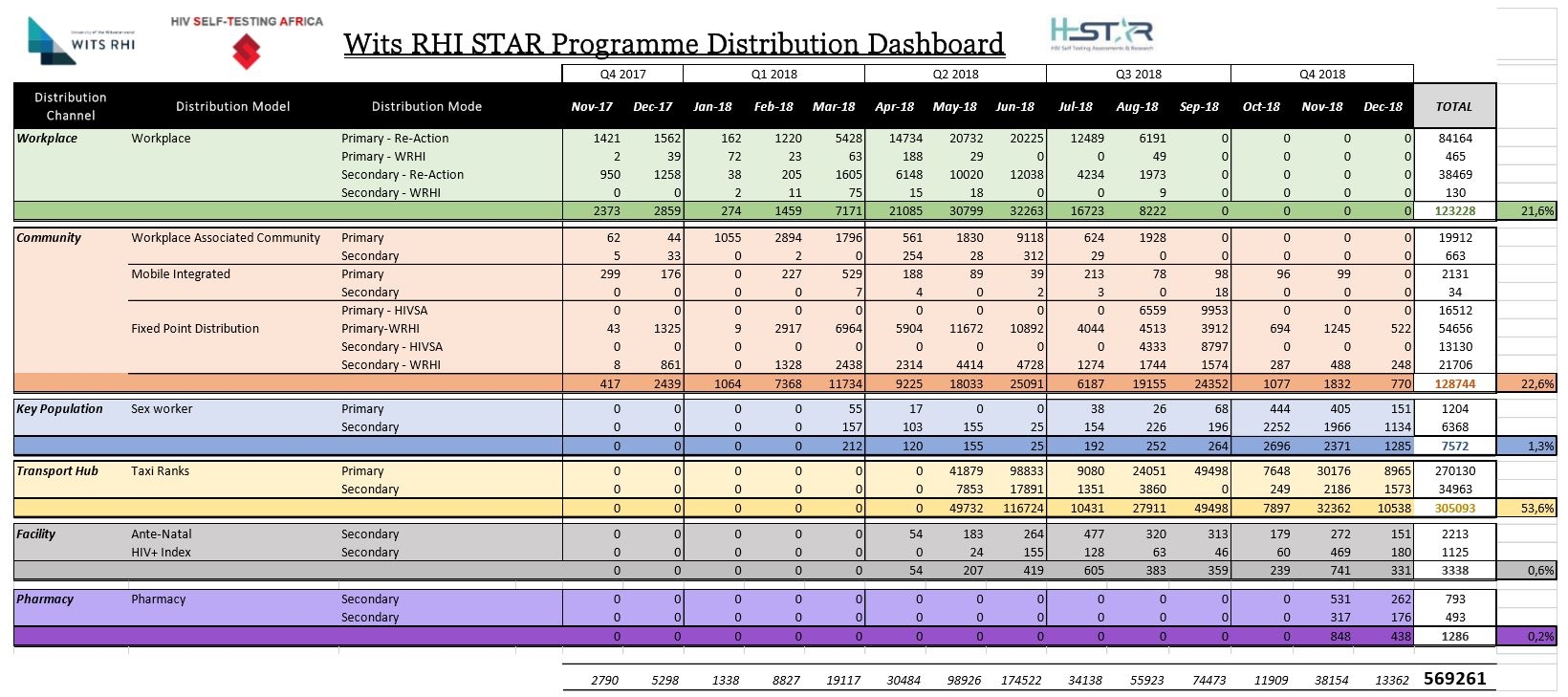IADR Abstract Archives
Progress on the scale up of HIV Testing in South Africa through varied distribution models using the Oral HIV Self-Test kit
Objectives: Self-Testing for HIV (HIVST) was approved as additional testing modality by the WHO in December 2016. The South African National Department of Health has adopted these guidelines and has sanctioned the assessment of various testing modalities to scale up HIV testing in response to the UNAIDS 90-90-90 targets. HIV Self-Tests are targeted at reaching infrequent, under-tested, and high risk populations. Herewith, we present the progress to date on the testing of various models of distribution through public and private sector initiatives.
Methods: Through the STAR Initiative, Wits RHI has distributed oral HIVST kits to primary recipients (end-users), and secondary distribution (to networks/partners) between November 2017 and December 2018. Models of distribution in the public sector include Community and Facility Based Distribution which target high prevalence areas, high volume transport hubs, and other facilities through which target groups can be reached. In the private sector, we have targeted Workplaces, Private Pharmacies, and waiting rooms of Health Professionals. Basic demographic information, and testing frequency is routinely captured. Follow up and self-reporting of results is conducted through telephonic survey or other mHealth tools. We computed descriptive statistics for the distribution status.
Results: By the end of December 2018, Wits RHI has distributed 569 261 kits, with most of the kits distributed in various community models (n=433 837, 76%) followed by workplace (n=123 228, 21%). The distribution reached mostly men (n=366 083, 64%), clients who ever tested or did not test in the last year (n=109 228, 19%) and among these 8% had never tested before and 19% of the distributions has reached young people (12-24 years). Across the models, uptake is high among the primary recipients and the yield ranges between 5-7%.
Conclusions: The piloted models of distribution has been successful in reaching the target populations for the intervention. Survey data suggests that it is possible to measure yield and linkage into care. The greatest challenge facing HIVST is the flow of data to allow policy makers and public health officials to make informed decisions. Further refining of these models is required to properly place HIVST into the bouquet of HIV Testing Services available to the populace.
Methods: Through the STAR Initiative, Wits RHI has distributed oral HIVST kits to primary recipients (end-users), and secondary distribution (to networks/partners) between November 2017 and December 2018. Models of distribution in the public sector include Community and Facility Based Distribution which target high prevalence areas, high volume transport hubs, and other facilities through which target groups can be reached. In the private sector, we have targeted Workplaces, Private Pharmacies, and waiting rooms of Health Professionals. Basic demographic information, and testing frequency is routinely captured. Follow up and self-reporting of results is conducted through telephonic survey or other mHealth tools. We computed descriptive statistics for the distribution status.
Results: By the end of December 2018, Wits RHI has distributed 569 261 kits, with most of the kits distributed in various community models (n=433 837, 76%) followed by workplace (n=123 228, 21%). The distribution reached mostly men (n=366 083, 64%), clients who ever tested or did not test in the last year (n=109 228, 19%) and among these 8% had never tested before and 19% of the distributions has reached young people (12-24 years). Across the models, uptake is high among the primary recipients and the yield ranges between 5-7%.
Conclusions: The piloted models of distribution has been successful in reaching the target populations for the intervention. Survey data suggests that it is possible to measure yield and linkage into care. The greatest challenge facing HIVST is the flow of data to allow policy makers and public health officials to make informed decisions. Further refining of these models is required to properly place HIVST into the bouquet of HIV Testing Services available to the populace.

